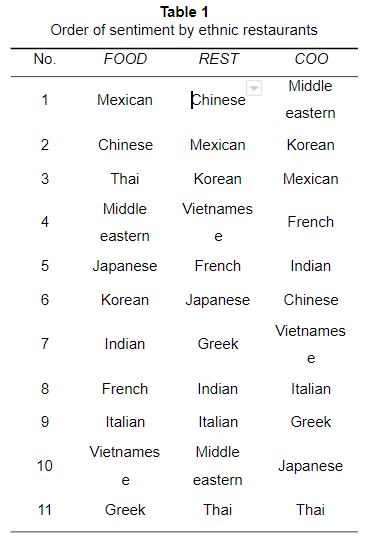How Consumer Perceptions Affect Ethnic Restaurant Location Patterns

By Sean (Sangwon) Jung, Ph.D., Assistant Professor of Hospitality Analytics, Boston University School of Hospitality Administration
Introduction
Ethnic restaurants in the U.S. have been consistently growing. So much so that according to the U.S. census bureau, ethnic restaurants have increased by an impressive 45% from 2002 to 2012, while the total number of restaurants have only increased by 19%. More interestingly, the interest of non-mainstream ethnic food has been the main reason for this increase, where non-mainstream ethnic restaurants increased by 66% within the same timeframe. Though there are many reasons as to why we observe an upward trend in ethnic restaurant establishments, it is quite apparent that people are becoming more accepting of other cultures. Today, we often see a diverse group of people who spend their time amongst friends with different ethnic backgrounds and food is one aspect people enjoy sharing. This shift of perception has also changed the general acceptance of ethnic restaurants. The term “ethnic restaurant,” which is defined as restaurants that serve cuisines that are not common to the regional consumers (Leung, 2010), has experienced a change in tone where dining out in ethnic restaurants has become an enjoyable experience.
When considering ethnic restaurant demand, this change in acceptance is coming from non-ethnic consumers (who are not the same ethnic group as the ethnic restaurant) who have unique perceptions that trigger acceptance which ethnic group consumers do not have. To name a few, consumers from the non-ethnic group carry the perception of the country of origin, the acceptance of exotic food, and acceptance of ethnic restaurants by a different culture. In contrast, the ethnic group that matches the ethnic restaurant theme do not have these perceptions. However, they live in clustered communities that share values and provide easier access to jobs (Ram et al., 2000).
Acknowledging these two differences which are (1) difference in acceptance from non-ethnic groups and (2) different living patterns from ethnic groups, the decision to select a location near or away from competitors for ethnic restaurants should be quite different as opposed to decisions that non-ethnic restaurants make. For instance, the best strategy for ethnic restaurants that have low acceptance because of low perception would be to locate in clustered regions within the ethnic community. This would help reduce risk of having no demand, since demand from the ethnic group that matches the ethnic restaurant exists within the community. In addition, by having the same ethnic restaurants clustered in one region, it helps reduce search cost for non-ethnic consumers which aids in representing quality assurance (Marshall, 1890; Jung & Jang, 2019). However, the disadvantage of having all ethnic restaurants agglomerated in one region is competition eroding everyone’s profit (Hotelling, 1929). Nevertheless, ethnic restaurants have no choice but to cluster within their ethnic communities since non-ethnic consumers have low acceptance of the particular ethnic restaurant theme. In contrast, for ethnic restaurants that have high acceptance, the best strategy is to diffuse from each other since each ethnic restaurant will avoid competition from similarly themed ethnic competitors. This would provide the ethnic restaurant an opportunity to maximize their profits.
The analogy suggests a theory that ethnic restaurant clustering patterns might be explained by non-ethnic group acceptance, where higher acceptance from this group will result in ethnic restaurant themes staying away from each other to reduce competition. The following results attempt to prove this research question: “Do ethnic restaurants try to locate away from each other when they have higher acceptance from non-ethnic consumers?”
Method
Identifying the ordering of perceptions for each ethnic restaurant theme using tweets
To identify acceptance, this study used Twitter to identify three types of acceptance which were food perceptions (FOOD), restaurant perceptions in general (REST), and perceptions of the country of origin (COO). The study used sentimental analysis through text mining to identify the three acceptances. Sentimental analysis uses words in a given sentence to identify how positive or negative a tweet is. For this reason, a word list of positives and negatives was required. For this study, Hu and Liu’s (2004) word list (https://www.cs.uic.edu/~liub/FBS/sentiment-analysis.html#lexicon) was used to identify the opinion for each ethnic restaurant theme. As an example of how sentimental analysis was used, if an individual wrote “I love Italian food” in a tweet, this would be considered as positive +1 since it consists of one positive word, “love,” with no negative word for Italian food perception. By using this method, we find perceptions of food, restaurants, and countries of origin for each ethnic theme restaurant that are then converted to numbers. Finally, using the numerical value for each ethnic theme, we find the average value of each ethnic restaurant theme as well as the order of perception which is presented in table 1.

Identifying restaurant clustered intensity for each ethnic restaurant theme
To identify the intensity of clustered patterns, an index was created by identifying the percentage of restaurant agglomeration for each restaurant within a set number of miles over the total number of restaurants in the city, divided by the total number of restaurants in each theme. In other words, the index indicates how clustered the ethnic restaurant is in a region by identifying the density of similar ethnic-themed restaurants surrounding it, which represents competition intensity.
Results and Conclusion
The results on how perception affects ethnic restaurants cluster patterns
By using the ordering pattern and the index that was created for this study, we ran a model for radiuses between 0.2 mile and 1 mile. Results showed ethnic restaurant themes that had higher acceptance were more diffused than ethnic restaurant themes that had lower perception. Interestingly, this was observed across all acceptance, which further supports the claim that non-ethnic group perception determines how ethnic restaurants locate. For practitioners, this suggests that the decision to locate near similar competition should be determined by how comfortable non-ethnic consumers are with the ethnic food theme. If the region that was selected to establish an ethnic restaurant theme has consumers that are not aware of, or have low acceptance of an ethnic cuisine, restaurant atmosphere or country of origin culture, it is best to locate in regions where ethnic groups that match the restaurants theme reside, as well as near similar-themed competitors. However, if it is a well-established ethnic restaurant theme, such as Mexican or Chinese restaurants, the study results suggest it is best practice to diffuse away from competitors.
Acknowledgments
I would like to give special thanks to Peter Bheda from Boston University School of Hospitality Administration for the helpful comments. The article was accepted by Mark Legg, Ph.D., Boston University School of Hospitality Administration.
References